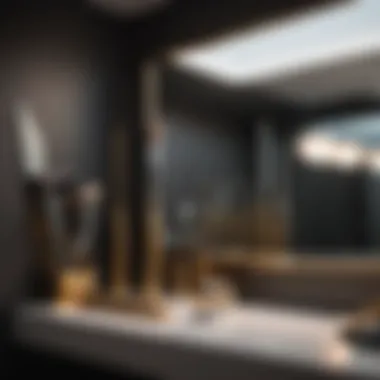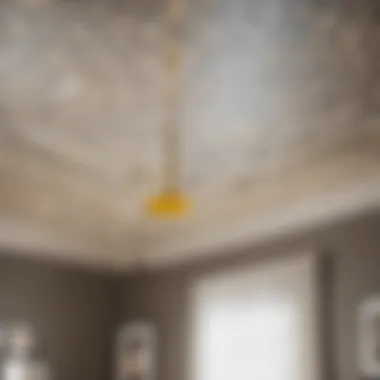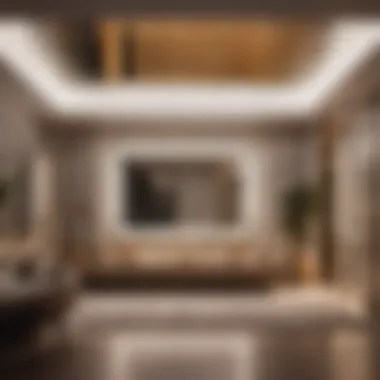Materials:
- 1 large mirror (dimensions: 36" x 48")
- Ceiling adhesive (2 tubes)
- Heavy-duty ceiling hooks (4 pieces)
- Measuring tape
- Pencil
- Level
- Ladder
- Screwdriver
- Silicone sealant
- Safety goggles
DIY Steps:
- Measure the desired placement area on the ceiling for the mirror using a measuring tape and mark it with a pencil.
- Position the heavy-duty ceiling hooks equidistantly within the marked area, ensuring they are securely attached to the ceiling.
- Apply a generous amount of ceiling adhesive around the edges of the mirror for proper adhesion.
- Carefully lift the mirror and place it onto the ceiling hooks, adjusting it to ensure it is level and centered.
- Secure the mirror in place by gently pressing it down, allowing the adhesive to set.
- Once the mirror is in position, seal the edges with silicone sealant for added stability and a polished finish.
Technical Aspects:
- Tools: Measuring tape, pencil, level, ladder, screwdriver, safety goggles
- Timing: Allow approximately 1-2 hours for the complete installation process
- Critical Techniques: Ensure precise measurements, use protective gear, follow safety guidelines, and double-check the mirror's placement
DIY Project Process:


- Prepare the area by clearing any obstructions and ensuring a clean, flat surface for work.
- Begin by affixing the ceiling hooks securely to the ceiling, ensuring they can withstand the weight of the mirror.
- Follow the instructions provided with the ceiling adhesive to ensure proper application and adhesion.
- Take caution while handling the mirror to prevent damage or injury during installation.
- Use the level to confirm that the mirror is correctly positioned and adjust if necessary.
- In case of any mishaps or misalignments, troubleshoot by carefully removing the mirror and realigning before the adhesive sets.
Introduction


In the realm of interior design and home improvement, installing a mirror on the ceiling can be a game-changer. This article dives deep into the meticulous process of adding a ceiling mirror to your space, offering a seamless blend of functionality and elegance. Understanding the nuances of this endeavor is key to ensuring a successful outcome.
Understanding the Purpose
Analyzing the need for a ceiling mirror
When considering the need for a ceiling mirror, one must first acknowledge its transformative impact on a room. The reflective nature of a ceiling mirror can create an illusion of spaciousness and add a touch of sophistication to any setting. By strategically placing a mirror on the ceiling, natural light can be dispersed more effectively throughout the space, enhancing its overall brightness. The practical benefits of utilizing a ceiling mirror are vast, making it a popular choice for those seeking to elevate their interiors.
Assessing Feasibility
Evaluating structural integrity
The feasibility of installing a ceiling mirror hinges heavily on evaluating the structural integrity of the chosen location. It is crucial to ensure that the ceiling can support the weight of the mirror securely. Factors such as the material of the ceiling and the presence of adequate support beams play a significant role in determining the feasibility of this undertaking. While the allure of a ceiling mirror is undeniable, careful assessment of the structural integrity is imperative to avoid any safety hazards or structural damage.
Preparation


Preparing for the installation of a mirror on the ceiling is a critical step that sets the foundation for a successful outcome. In this article, we delve deep into the importance of meticulous preparation, emphasizing specific elements that play a vital role in achieving a seamless installation process. By focusing on thorough preparation, you not only ensure a smooth execution but also enhance the safety and longevity of the mirror.
Choosing the Right Mirror
When it comes to choosing the right mirror for your ceiling installation, several factors come into play. One key aspect to consider is size considerations. The size of the mirror impacts the overall aesthetics and functionality of the space. By selecting the appropriate size, you can create a harmonious design while ensuring practicality. Additionally, the weight factor of the mirror is crucial in determining the suitable mounting method. By understanding the weight considerations, you can guarantee the mirror's stability and durability over time.
Size considerations
Size considerations play a pivotal role in determining the visual impact and functionality of the ceiling mirror. Opting for the right size ensures that the mirror complements the room's dimensions and serves its purpose effectively. Larger mirrors can create an illusion of space and add glamour, while smaller mirrors may be more discreet but equally impactful in certain settings. It's essential to assess the space where the mirror will be installed to make an informed decision on the ideal size.
Weight factor
The weight factor of the mirror influences the choice of mounting hardware and installation method. Heavier mirrors require robust support to prevent any safety hazards and structural damage. Understanding the weight factor not only guarantees a secure installation but also enhances the mirror's longevity. By selecting a mirror that aligns with the weight specifications, you can ensure a reliable and durable ceiling installation.
Selecting the Location
The location of the ceiling mirror plays a significant role in its functionality and visual impact. Optimal placement is key to maximizing the mirror's reflective properties and aesthetic appeal. By strategically positioning the mirror, you can create a focal point in the room and elevate its overall design. Alongside optimal placement, safety precautions are paramount to safeguarding both the mirror and the occupants of the space.
Optimal placement
Optimal placement involves identifying the strategic position where the mirror can reflect light effectively and enhance the space's ambiance. Placing the mirror opposite a window or light source can amplify natural light and make the room appear brighter and more spacious. Additionally, considering the room's layout and purpose can help determine the ideal location for the ceiling mirror, ensuring it serves its intended function seamlessly.
Safety precautions
Prioritizing safety precautions during the location selection process is crucial to prevent accidents and ensure a secure installation. Factors such as avoiding installation near electrical outlets, ensuring the ceiling can support the mirror's weight, and using appropriate mounting hardware are essential safety measures. By adhering to safety protocols, you can mitigate risks and enjoy a worry-free experience with your ceiling mirror.
Gathering Necessary Tools
Before embarking on the installation process, gathering the required tools is essential for a smooth workflow and efficient completion. Having the necessary tools at hand minimizes disruptions and ensures precision in executing each step. By assembling the tools beforehand, you can streamline the installation process and achieve professional results.
List of tools required
The list of tools required for installing a mirror on the ceiling includes essential items such as a stud finder, measuring tape, drill, level, mounting brackets, screws, and safety goggles. Each tool serves a specific purpose in the installation process, from marking the anchor points to securing the mirror in place. By having the complete set of tools available, you can tackle challenges effectively and navigate the installation with confidence.
Installation Process
Marking and Measuring
Determining Anchor Points
Determining anchor points is a critical aspect of the marking and measuring stage. Anchor points serve as the foundation on which the mirror will be securely placed on the ceiling. By accurately identifying and marking these points, you can ensure that the mirror is aligned correctly and can bear the appropriate weight. This step is essential in guaranteeing the stability and safety of the installed mirror. Utilizing the right tools for this task, such as a measuring tape and a level, will contribute to the accuracy of determining anchor points, an essential consideration in this installation process.
Measuring Accurately
Measuring accurately is paramount in ensuring a precise installation of the ceiling mirror. Proper measurements guarantee that the mirror fits perfectly within the chosen location and that it is aligned as intended. Precision in measuring avoids potential issues such as misalignment or instability of the mirror. Taking into account factors like ceiling height, mirror dimensions, and surrounding furniture is crucial for achieving a seamless and visually appealing result. Accurate measurements are a fundamental aspect that significantly impacts the overall success of this installation project.
Securing the Mirror
Securing the mirror involves choosing appropriate fasteners that will support the weight of the mirror and ensure its stability once installed. The type of fasteners selected should align with the ceiling material and the weight of the mirror to prevent any risks of falling or detachment. Safety considerations play a significant role in this aspect, as choosing reliable and durable fasteners is essential for maintaining the integrity of the installation. By carefully selecting the proper fasteners, you can enhance the longevity and functionality of the ceiling mirror.
Final Adjustments
Checking Alignment
Checking alignment is a crucial step in the final adjustments of the installation process. Alignment ensures that the mirror is parallel to the ceiling and walls, providing a symmetrical and visually pleasing appearance. By verifying the alignment, any discrepancies can be rectified to achieve a balanced and harmonious integration of the mirror into the space. Attention to detail in alignment is a key factor that contributes to the overall aesthetics and functionality of the installed ceiling mirror.
Ensuring Stability
Ensuring stability guarantees that the ceiling mirror is securely in place and resistant to any potential movement or shaking. Stability is essential for maintaining the safety and longevity of the installation. By implementing measures to secure the mirror firmly and mitigate any risks of displacement, you can enjoy a durable and stable addition to your space. Emphasizing stability in the final adjustments phase is essential for maximizing the usage and visual impact of the ceiling mirror.
Completion
Completing the installation process of a ceiling mirror is a crucial phase that ensures the project's success. For finishing touches, the steps involved go beyond mere aesthetics and delve into the practical aspects of maintenance and longevity. Addressing every detail in the final stages will enhance the overall look and functionality of the mirror, elevating the space's appeal and utility to a new level. By adhering to the strategies outlined in this article, you will not only achieve a visually pleasing result but also ensure the mirror's durability and performance.
Finishing Touches
Cleaning the mirror
Cleaning the mirror is a pivotal aspect of maintenance that directly influences its appearance and longevity. Regular cleaning preserves the mirror's reflective surface, preventing dullness or distortions. Utilizing industry-recommended cleaning solutions and techniques guarantees a streak-free finish and removes any accumulated dust or stains, maintaining the mirror's pristine condition. Additionally, cleaning the mirror at regular intervals will uphold its original shine and clarity, contributing to an aesthetically pleasing ambiance in the room. Proper cleaning procedures also extend the mirror's lifespan, avoiding issues such as corrosion or deterioration.
Enhancing aesthetics
Enhancing the aesthetics of the mirror involves accentuating its visual impact within the space. By strategically placing lighting fixtures or decorative elements around the mirror, you can create a focal point that amplifies the room's atmosphere. Choosing complementary frames or borders further enhances the mirror's presence, adding a touch of elegance or style to the décor. Incorporating artistic or functional elements around the mirror enhances its overall appeal, transforming it into a statement piece that reflects the room's design theme. Careful consideration of the surrounding elements ensures a harmonious and polished look, elevating the mirror from a mere functional object to a captivating decorative feature.
Safety Measures
Securing for longevity
Securing the mirror for long-term usage involves using appropriate mounting hardware and following manufacturer-recommended installation guidelines. By ensuring that the mirror is securely attached to the ceiling with sturdy anchors and brackets, you prevent unexpected falls or accidents. Anchoring the mirror according to its weight specifications and the ceiling's load-bearing capacity guarantees its stability and durability over time. Prioritizing secure fastening methods and periodic inspections for loose fittings safeguards the mirror's structural integrity, providing peace of mind and safety assurance for inhabitants.
Regular maintenance
Regular maintenance is essential for preserving the mirror's pristine condition and extending its lifespan. Routine inspections for scratches, cracks, or tarnishing allow for timely repairs or replacements, preventing further damage. Cleaning the mirror periodically with mild cleaners and soft cloths maintains its luster and clarity, ensuring consistent reflection quality. Implementing preventive measures such as humidity control or protective coatings shields the mirror from environmental factors that could compromise its integrity. By committing to a maintenance routine, you uphold the mirror's functionality and aesthetics, prolonging its usability for years to come.





